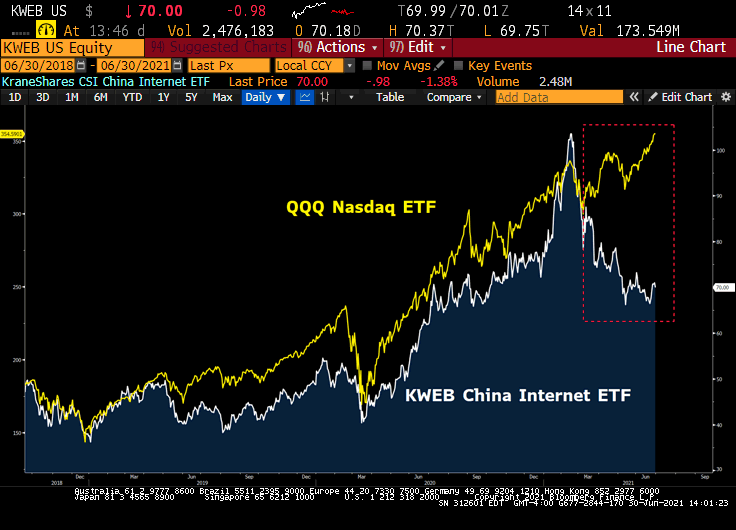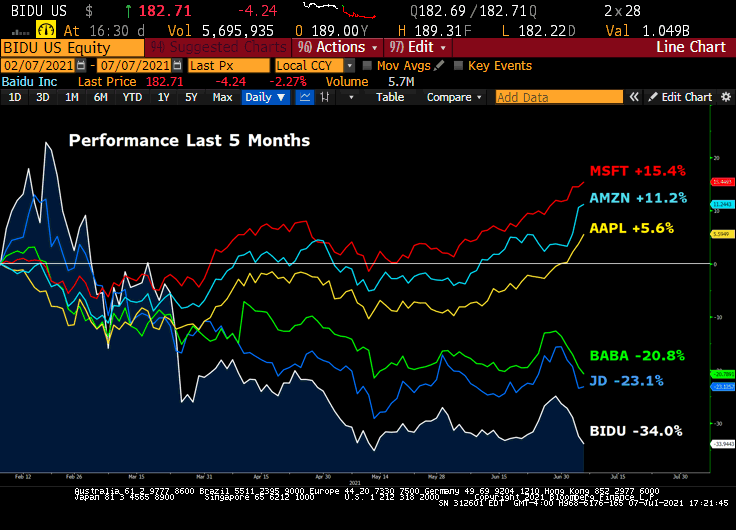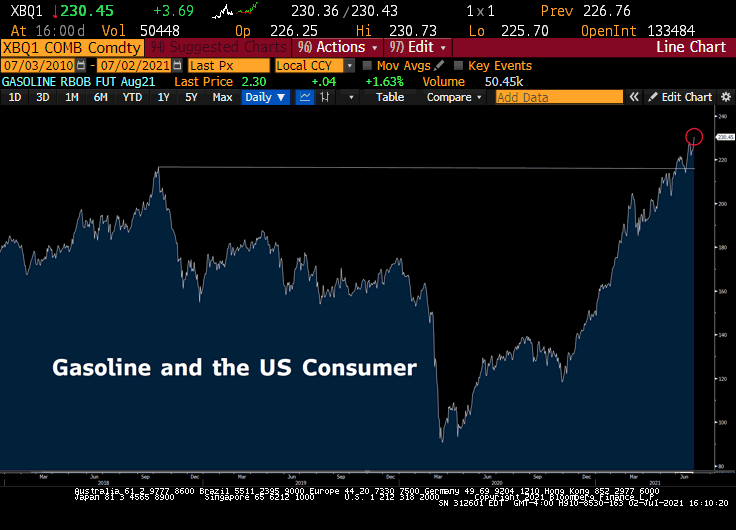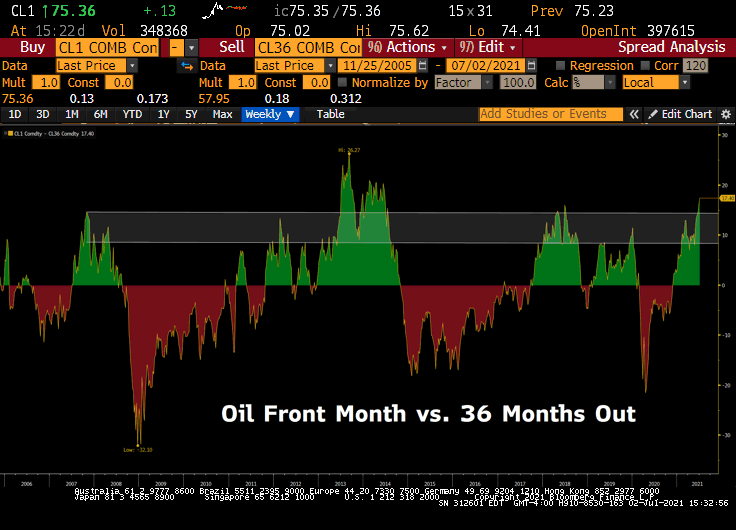Breaking July 9:
Biden Administration to Give Technology Mergers Greater Scrutiny
Many of the large platforms’ business models have depended on the accumulation of extraordinary amounts of sensitive personal information and related data.
In the Order, the President:
Encourages the FTC to establish rules on surveillance and the accumulation of data.
Big Tech platforms unfairly competing with small businesses: The large platforms’ power gives them unfair opportunities to get a leg up on the small businesses that rely on them to reach customers. For example, companies that run dominant online retail marketplaces can see how small businesses’ products sell and then use the data to launch their own competing products. Because they run the platform, they can also display their own copycat products more prominently than the small businesses’ products. BN
Institutional investors can join our live chat on Bloomberg. Since 2010, a groundbreaking venue with participants now in 23 countries.
Please email tatiana@thebeartrapsreport.com.
Thank you. LGM.
An Important Message from Jason Hsu and Larry McDonald
30% off sale – “Didi Extends Drop to Fresh Lows as China Weighs Rule Changes – Ride-hailing company has lost $17 billion in value this week – China plans changes to block firms from listing overseas” – Bloomberg
The future of Chinese Tech and ADRs: What can we learn from DiDi and Ant?
Much has happened this week in the Chinese tech and ADR space. Below are our thoughts in response to some of the questions I’ve been receiving from investors and others.
“The US IPO conveyor belt needs to slow down. US banks MUST do more due diligence. With 30 more China-based IPOs in the pipeline, look for the SEC to put the breaks on any day now.”
Larry McDonald, Founder of the Bear Traps Report
China Internet KWEB vs. Nasdaq 100 NDX
 Equity markets have been pricing in pain for weeks in China big tech.
Equity markets have been pricing in pain for weeks in China big tech.
Is DiDi Ant Financial redux?
On July 6th, DiDi plunged 20% following the news of (1) a formal investigation by the Chinese Cyber Security Administration and (2) a temporary removal of its app from all app stores in China. Many western investors viewed this the same as Ant Financial’s scuttled IPO last year. Their analysis started and ended with, “What did DiDi say to piss off Beijing?!”
This is far from the correct interpretation; Didi is not Ant Financial Redux. Let us explain why these two are not even close.
“The SEC should rescind the DIDI offering and protect US investors from China’s shenanigans. It’s time to protect US investors from Xi Jingping. Yet another example as to why China’s companies should BE FORCED TO ADHERE to the same standards as US companies.”
Kyle Bass, CIO Hayman Capital Management
An obvious indicator of the difference between these two is that the Chinese regulator halted the Ant Financial IPO in its tracks. By contrast, it politely waited until one week after the DiDi IPO before announcing a formal investigation. If the Chinese regulator believed DiDi’s deficiencies could not be resolved to its satisfaction or would jeopardize DiDi’s operations in mainland China, it would have asked DiDi to pull its U.S. IPO – and DiDi would have complied. The fact that it allowed DiDi’s IPO to proceed is significant.
Some have suggested Beijing has exercised enforcement unevenly against DiDi and Ant Financial, unfairly targeting Jack Ma for harsher treatment. Again, this is not the correct interpretation. For starters, Ant and DiDi are both incredibly plugged-in and aided by the most connected powerbrokers in China. Rounds of informal but deliberate conversations will have occurred and agreements reached in both cases before anything formal is announced in the press. The key difference is that for Ant Financial, the regulatory deficiency was too great to be remedied under the existing model. To the extent there is reasonable dissatisfaction with Beijing’s handling of Ant Financial, it is that the regulator waited too long to act.
Didi’s IPO was allowed to proceed precisely because, unlike Ant Financial, Beijing believed the company’s deficiencies can be remedied. The concerns regarding data privacy are easily addressable and the punishment—temporary removal of the DiDi hailing app from app stores—insignificant in the long-term. DiDi’s hailing app is, after all, already on every smartphone in China through WeChat.
There is no doubt that Beijing intended to make a point with by announcing the formal investigation. Sending a signal to other industry players is often a primary objective when there are public sanctions against the clear industry leader for industry-wide infractions. However, the issue at hand is relatively minor. The regulator was apathetic enough to be willing to agree to a delay in the formal investigation until after the IPO, and that tells you everything you need to know about the difference between DiDi and Ant Financial.
Don’t miss our next trade idea. Get on the Bear Traps Report Today, click hereIs Beijing going after Chinese tech firms listed in the U.S.?
Some of the issues the China regulator is investigating regarding DiDi are industry-wide, which means the government action has broader implications. This was on display when major indexes tracking Chinese tech ADRs took a major nosedive on July 6 – even though most of them had not yet added DiDi!
This is One, Unsustainable – Yet Impressive Divergence
 In the USA, close to 92% of corporate profits sit in the hands of the largest 100 companies, up from 57% in the 1990s, per the Wall St. Journal. Monopoly power is on the rise as Washington is on the sidelines, for now.
In the USA, close to 92% of corporate profits sit in the hands of the largest 100 companies, up from 57% in the 1990s, per the Wall St. Journal. Monopoly power is on the rise as Washington is on the sidelines, for now.
Clearly, the market is reading something much bigger into DiDi’s cybersecurity investigation. Investors are now concerned about all tech firms that store massive amounts of data and perform analyses on Chinese citizens and businesses. The Chinese government, like the U.S. government, does not want those servers to run on foreign hardware and software, which could make them vulnerable to foreign spyware. Tech firms are squarely in the regulator’s bullseye.
Meanwhile, the government’s claim against many of the same tech giants for anti-competitive business practices also looms large. The Ant Financial action served to signal zero-tolerance for innovations the regulator feels may circumvent financial stability regulations. This has caused tech players to abandon one of their core business strategies—taking a slice of the massive Chinese consumer finance market while avoiding the high compliance cost of distributing financial products. This was a valuable business. So yes, it appears a revaluation might indeed be warranted for all Chinese consumer tech giants. But that is hardly due to Beijing turning anti-tech or even anti-capitalism— it is just Beijing discharging its duty as the steward of China, Inc.
It may appear to some outsiders that China is targeting the firms that have chosen to list in the U.S.. After all, many of the most highly scrutinized firms –like Alibaba, JD.Com, Meitun and now DiDi – are widely held ADRs. But this is far from the truth, and it is a matter of correlation rather than causation. Stated differently, these firms are not being targeted because they are listed in the U.S.
Most of the U.S.-listed consumer-tech firms pursued listing in the U.S. not because they were “defecting” from China in pursuit of a better venue. These Chinese firms listed in the U.S. because they could not receive approval for listing back home. Alibaba, for example, could not gain approval for listing in mainland China or Hong Kong because of its corporate governance deficiencies, where Jack Ma as a small shareholder could always out-vote everyone. DiDi also actively explored listing on the mainland exchanges in addition to HKEX before it decided those paths were nearly impossible due to their various unresolved compliance issues related to China’s labor laws and tax codes (think Uber in the U.S.). The growing concern around DiDi’s ability to generate positive cashflow and reach profitability also made local regulators queasy about approving the company for listing, especially given the recent froth in tech shares. For DiDi, the quickest path to unlock liquidity for its founding core and its PE backers before the global tech euphoria recedes was to dash for the U.S. From filing to listing, DiDi took only 20 days, and priced at the top of the range. Heck, if Lyft can list successfully while stating in its prospectus that it has no business model toward eventual profitability, then surely DiDi can make a fine listed company on the NYSE.
When you consider that many firms listed in the U.S. are tech firms that listed here precisely because there were facing domestic regulatory concerns, it should be no surprise to find that a disproportionate number of the firms facing investigation are those listed in the U.S.
Don’t miss our next trade idea. Get on the Bear Traps Report Today, click hereUnderstanding Chinese Regulators
Those seeking to understand Ant Financial, DiDi, or other regulatory actions in China should start their analysis by understanding the differences between the U.S. and Chinese regulatory approaches.
Chinese regulators are interventionist. They so this, in part, because their financial markets are dominated by unsophisticated retail investors. Appealing to the wise invisible hand of an efficient market is a luxury that Beijing does not have. Thus Chinese regulators have to set P/E caps for IPO pricing to avoid irrational retail investors bidding prices to astronomical ranges during the subscription period. Thus Chinese regulators chose to take time to vet company financials and business model independently before approving listings. There is real personal career risk for the regulator who approves a firm that turns out to be a fraud or that craters in price due to its inability to execute on the promised business plan.
What Is An Investor To Do?
Foreign investors wishing to invest in Chinese firms must also accept a higher frequency of government intervention at the market, industry, and firm level. They should also understand that this intervention is not driven by senseless bureaucracy or a desire to punish success. The China’s regulator intervenes because it has a foundational (and sensible) lack of trust in its own inefficient capital markets. In China, the invisible hand wears a red glove.
About our Associate Jason Hsu
Jason Hsu is the founder and chairman of Rayliant Global Advisors. Throughout his accomplished career, Jason’s commitment to academic rigor and investor advocacy have led him to research, develop, and bring to market investment strategies that create significant value for investors. At Rayliant, Jason is continuing that commitment by educating investors and offering products to transform the investment ecosystem in Asia and beyond. Prior to his current role, Jason was the co-founder and vice chairman of Research Affiliates.
Jason is at the forefront of the smart beta revolution and is one the world’s most recognized thought leaders in that space. Building on his pioneering work on the RAFI™ Fundamental Index™ approach to investing with Rob Arnott in 2005, he has published numerous articles on the topic, notably his articles “A Survey of Alternative Equity Index Strategies,” which won a 2011 Graham and Dodd Scroll Award and the Readers’ Choice Award from CFA Institute; and “The Surprising Alpha from Malkiel’s Monkey and Upside-Down Strategies,” which won the 2013 Bernstein Fabozzi/Jacobs Levy Award for Outstanding Paper in the Journal of Portfolio Management. In 2015, Jason received the Bernstein Fabozzi/Jacobs Levy Outstanding Article Award for “A Study of Low-Volatility Portfolio Construction Methods” published in the Journal of Portfolio Management. He has twice received the William F. Sharpe Award for Best New Index Research (2005 and 2013), which is awarded by Institutional Investor Journals.
Don’t miss our next trade idea. Get on the Bear Traps Report Today, click here
 After the U.S. handed far more control over the price of oil to the Saudis and Russians, consumers are paying the price. The White House wants this problem fixed by the time the 2022 midterm elections come around.
After the U.S. handed far more control over the price of oil to the Saudis and Russians, consumers are paying the price. The White House wants this problem fixed by the time the 2022 midterm elections come around.  “It is time to think of the oil curve CL1 (front-month futures contract) is priced at $75.16 vs. CL36 (36 months out futures contract) down at $57.95. As you can see above the spread above is eye-opening looking back from 2005 to 2021. “Larry, the one-year backwardation roll is 11%, just wow” says
“It is time to think of the oil curve CL1 (front-month futures contract) is priced at $75.16 vs. CL36 (36 months out futures contract) down at $57.95. As you can see above the spread above is eye-opening looking back from 2005 to 2021. “Larry, the one-year backwardation roll is 11%, just wow” says 
